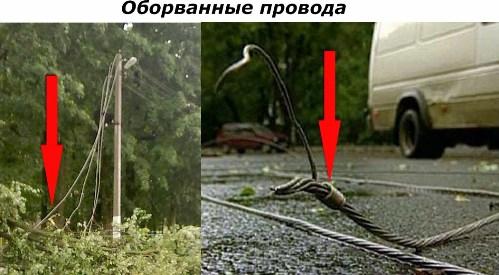Categories: Electrician at home, Safety precautions
Number of views: 20298
Comments on the article: 4
How to protect children from electric shock
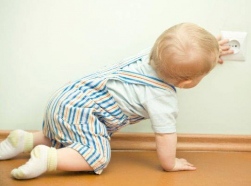 Electricity brings many benefits to man. But it is dangerous, especially for children. If an adult already has a certain life experience and knows basic safety rules, then children, especially small ones, only know this world. They are curious, active, agile, and evaluate everything that surrounds them with their senses.
Electricity brings many benefits to man. But it is dangerous, especially for children. If an adult already has a certain life experience and knows basic safety rules, then children, especially small ones, only know this world. They are curious, active, agile, and evaluate everything that surrounds them with their senses.
Children examine all the objects around them, touch them with their hands, they can stick them in their mouths, lick their tongue or bite their teeth, chew. In this way they gain experience for later life. However, the human senses are not able to determine the presence of tension, and children do not understand its dangers. Parents and all adults are obliged to create safe conditions for their life, to teach the accurate handling of electrical appliances.
Providing these conditions requires a differentiated, individual approach, taking into account children's age. Kids up to 3-5 years old are usually under the scrutiny of parents and caregivers at home, on the street and in kindergarten. To ensure their safety, it is enough to maintain the electrical wiring of the apartment in a technically sound condition, block access to outlets, household appliances and individual wires.
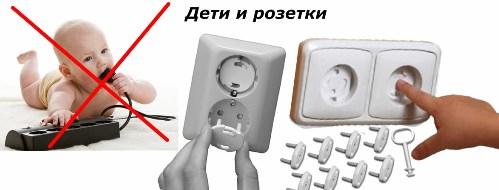
This is done with a fairly simple installation of plastic dielectric plugs, available in a wide range. After placing them and securing them into the contact sockets, the baby will not be able to stick studs, nails, knitting needles and any other metal objects through which it may be exposed to current.
All switches and sockets in the apartment must be securely fixed. Children should not be allowed access to household appliances and their wires. Otherwise, they can pull on the electric cord or begin to test its mechanical strength with teeth or the first objects caught.
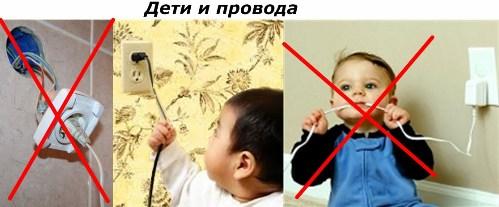
Danger for children is represented by the included table lamps, electric heaters, fans and other devices.
But limiting access to electrical equipment is not the only measure. The focus should be on safety education for children. Already at this age, they can remember well what their parents explain to them. It’s better to do it in a playful way, combine it with showing special educational children's cartoons and discuss the plot after watching.
Joint lessons with kids on safety, which are held by kindergarten teachers, have a good effect on children's behavior. Participation in a properly organized collective event allows them to exchange impressions with other children, which form a stable consciousness of correct behavior in various situations.
For children over five years old, parents already provide more freedom, less control over their actions, release some to participate in outdoor games with peers in the fresh air, riding a bicycle. At this point, it is important to formulate in the child a clear knowledge of the dangerous factors of electricity.
He must understand that electricity is transmitted by wire and represents a huge danger. You can’t climb the poles of power lines, play under them, throw any objects on the wires.
Children love collective games with kites, but they can only be played in open areas away from power lines. A kite can be thrown on wires by a stream of air, and this is a serious prerequisite for electric shock.
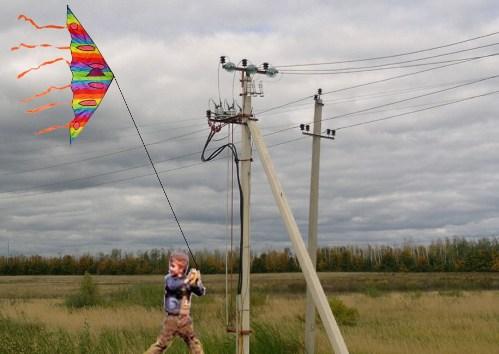
In the courtyards of houses or near them transformer substations, distribution cabinets are installed. One of the favorite children's games is hide and seek. Do not penetrate the enclosure of electrical equipment.This child must be clear.
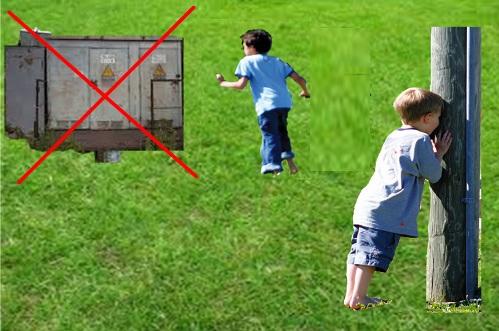
By the time children are given freedom to enter the yard, they must have developed an instinct:
-
Do not approach loose or torn wires (possibly striking stress);
-
not approach the enclosure of electrical equipment, even if it is closed;
-
Do not play near OHL poles;
-
Report any irregularities immediately to adults.
When a child grows up and goes to school, he gets even more freedom. This requires him to already have more knowledge of safe behavior and handling electrical equipment in the home and on the street.
Left alone at home, he should not:
-
independently turn on electrical appliances;
-
repair and remove protective covers from household appliances, replace fuses, electric lamps;
-
touch working devices with wet hands, and even more so wipe them or wash with water.
If a smell of burning insulation or sparking is detected, it is necessary to immediately de-energize the device, but you cannot pull the power cord by hand.
Being on the street in the company of peers, children commit “heroic” actions, demonstrating their dexterity, courage, accuracy and other qualities. They can try to break down insulators on overhead lines, climb to a height along the power transmission line poles, forgetting all safety lessons under the influence of mischievous people, or open locks of cabinets with electrical equipment.
Another dangerous place is a reservoir located near the power line. Fishing under the wires of power lines is strictly prohibited. When casting with a fishing line, a five-meter fishing rod increases the distance from the fisherman to the hook by 10 meters, which is enough to throw on the wires. On a wet fishing line, an electric current through a person’s body will immediately begin to flow into the ground, which is deadly.
Parents are obliged to discuss all these cases with their children, and more than once.
Even at school, under the supervision of a teacher, during classes in labor lessons or in laboratory work in physics or chemistry, danger of electric shock. To avoid them, the child must carefully follow all the instructions of the teacher, not engage in independent experiments and be naughty.
In many children's recreation camps, teachers together with power engineers began to conduct electrical safety lessons, which use videos, presentations and other effective teaching methods.
The main measures to protect children from electric shock are:
-
maintenance in a technically sound condition of electrical equipment;
-
timely repair of failed electrical appliances;
-
continuing education of the child in safe behavior measures, including handling electrical devices;
-
periodic monitoring of the behavior of children by parents and teachers.
In addition, all parents must know rules for first aid for children exposed to electric current. It must be understood that the very first action that must be performed very quickly is to de-energize the lesion site. The electric current passing through the muscles of the person causes a sharp contraction, due to this the victim can be under voltage for a long time. The best shutdown is made by modern means of protection: circuit breakers, RCD, difavtomaty.
But if they are not installed, then it is necessary to relieve tension manually using improvised protective equipment made of dielectric materials. At the same time, the assistance provider itself should not become a victim of electric current.
After disconnecting the voltage, you should immediately assess the condition of the child, his consciousness, pulse, breathing and, in any case, call a doctor. If there are no signs of life, then it is necessary to begin the provision of cardiopulmonary resuscitation: conducting artificial respiration and external heart massage.
The child carefully, but quickly lay their backs on a hard surface and open the airways for access of air. To do this, throw his head back and slightly raise his chin. They take air into the lungs and, in one second, make two exhalations into the child's mouth. His nose should be clamped with his fingers, and his lips should completely cover his mouth. Then the air will pass into the lungs, and the chest will rise.
Then you need to do 30 hand presses on the chest of the child. To do this, one palm is placed on the center of the sternum, and the other is laid at an angle on it. The magnitude of the pressure should be sufficient to create a circulation of blood circulation, but not exceed 1/3 or 1/2 of the depth of the chest. Otherwise, the ribs may be damaged. The pace of clicks should be fast - 100 movements per minute.
The presses are followed by two breaths into the child's mouth, and then 30 presses on the sternum and so on according to the cycle passed. During resuscitation measures, the condition of the pupils, the appearance of breathing, the restoration of the heart muscle are assessed.
First aid should be continued until the child is brought to her senses or the doctor arrives. Only he can assess the true condition of the victim and make a final decision on the completion of resuscitation.
Parents should be well aware of the danger posed by electrical energy and take whatever they can to avoid family accidents.
See also at e.imadeself.com
:

